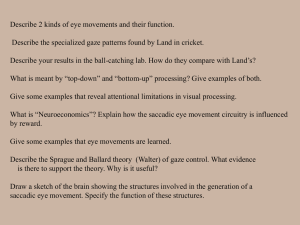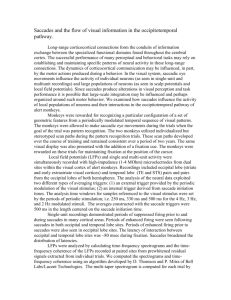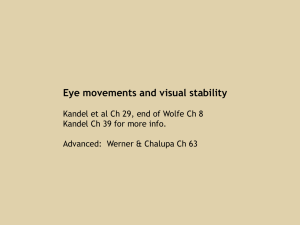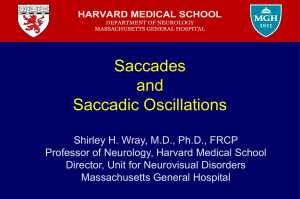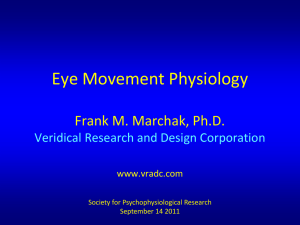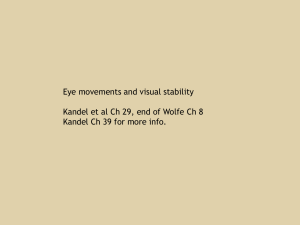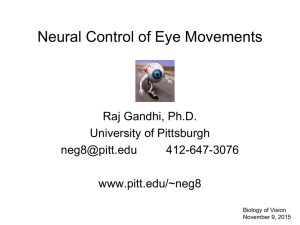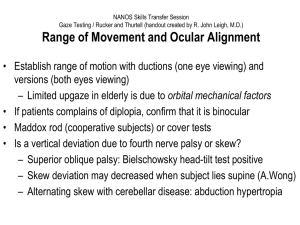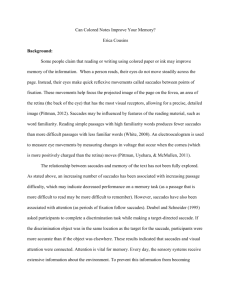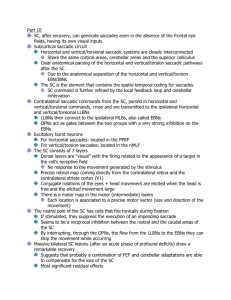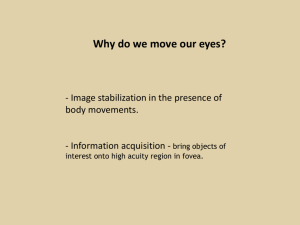Brain Control of Horizontal Saccadic Eye Movements
advertisement
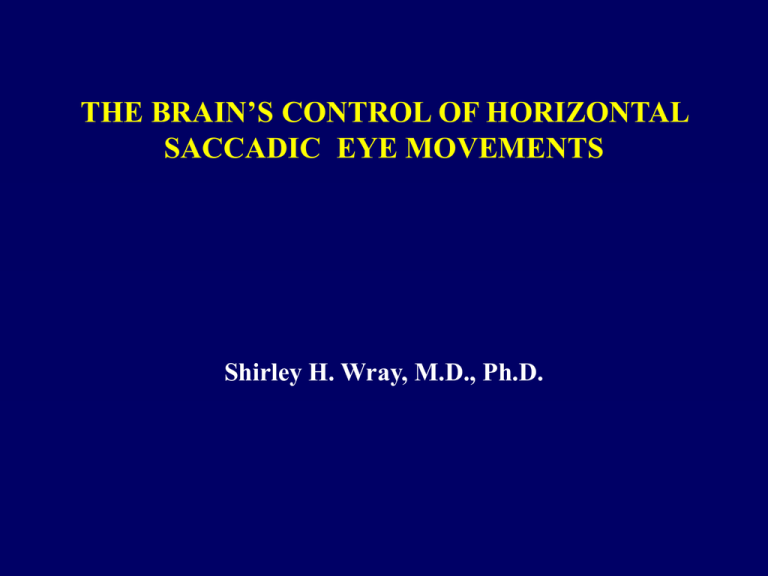
THE BRAIN’S CONTROL OF HORIZONTAL SACCADIC EYE MOVEMENTS Shirley H. Wray, M.D., Ph.D. The Brain controls how the eyes move by processing information in multiple well delineated cortical regions called eyes fields. http://www.inma.ucl.ac.be/EYELAB/neurophysio/perception_action/saccades.html Six Cortical Eye Fields Frontal eye field - FEF Parietal eye field - PEF Supplementary eye field - SEF Medial superior temporal area - MST Prefrontal eye field ( DLPFC ) - PFEF Precuneus region ( 7m in the monkey ) Interconnections Each EF is interconnected to all the other EFs and each has direct connections to the brainstem oculomotor system. http://www.inma.ucl.ac.be/EYELAB/neurophysio/perception_action EFs participate in other functions Higher cognitive function such as memory Decision-making Remapping of sensory signals Modulation of attention Planning of actions Cortical Activity At the cortical level potential targets for gaze are analyzed and selected and a decision is made to execute a saccadic eye movement from one target to another or a pursuit eye movement to follow a moving target Cortical Links Cortical function is linked to the functions of the superior colliculus, thalamus, basal ganglia, cerebellum and other subcortical structures Functional imaging permits analysis of the cortical network Two fMRI studies directly compared cortical activation during saccadic and smooth pursuit eye movements and found common cortical activation in the FEF,SEF, PEF, the Precuneus and MT/MST for saccade and pursuit eye movements Types of Saccades affected by Cortical Lesions Intentional – volitional, purposeful Reflexive – saccades to unexpected stimuli Express - short latency saccades to a novel stimulus after the fixation stimulus has gone Memory-guided – saccades to a previously presented target (i.e. visual memory ) Predictive – anticipatory saccades to a specific location Antisaccades – after instruction to look in the opposite direction of a suddenly appearing target. FEF controls a hierarchy of functions FEF Intentional saccades to visual targets Reflexive saccades Memory-guided saccades Antisaccades PEF initiates PEF Visuo-spatial attention by triggering visually guided reflexive saccades and disengaging fixation SEF plays a prominent role in directing SEF Voluntary sequences of saccades to specific positions Cerebrum Brainstem Cerebellum Spinal Cord Oculomotor Structures SEF PEF FEF MST SC Mes RF 3 4 PPRF 6 MV PH Med RF FOR N/F Uvula PF Dorsal Vermis Brainstem Machinery Midbrain V-T, VERGE Pons HORIZ Medulla HOLDING Midbrain Vertical & Torsional Gaze Center & Holding Center Vergence Center Saccade Center Cerebellum 3 4 Accuracy Center 6 Pons Horizontal Gaze Center Gaze-Holding Center (Horiz) Medulla Base Sections from DeArmond – Structure of the Human Brain Horizontal Muscle Actions 6 3 Base Artwork - http://info.med.yale.edu/caim/cnerves/cn3/cn3_3.html Hypothesis There is increasing evidence that eye movement control and visuo-spatial attention share a common network. The anatomical overlap supports the hypothesis that attentional and oculomotor processes are tightly integrated at the neural level. Observations Watch the patient’s random eye movements when he/she is talking to you The co-ordination of head movements with movement of the eyes Time the latency period for the initiation of a voluntary saccade after the command to look right or left. A delay greater than 200 msec is significant The speed of the saccade. Is it slow, too fast or normal ? Observations Is the saccade accurate , right on target or hypometric, short of the target or hypermetric , overshot the target Is the new position of gaze holding stable or are the eyes drifting back to the midline and then making a quick corrective saccade back resulting in gaze evoked nystagmus Horizontal Leftward Voluntary Saccade (“Look to the left”) 1. R Frontal Eye Field 2. R saccade center 3. L horiz. gaze center 4. L 6th nucleus (L eye out) 5. R MLF 6. R 3rd nucleus (R eye in) R L FEF Saccade Center Horiz. Gaze Center (PPRF) 3 - RMR R MLF 6 - LLR Base Artwork & Animations David E. Newman-Toker, MD Frontotemporal Dementia
